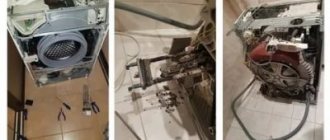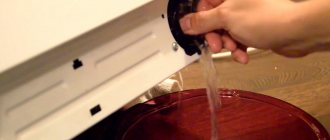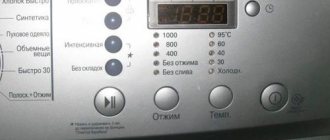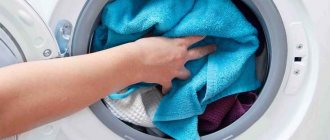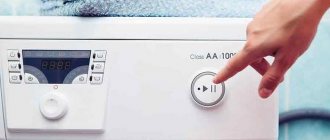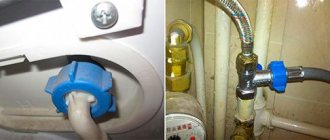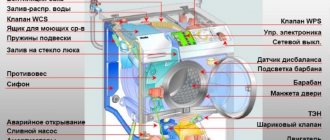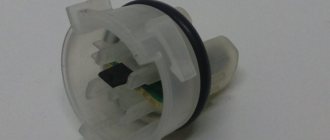A washing machine, like any other technically complex product, is not immune to breakdowns. One of the most common complaints among users is that the washing machine does not wash, that is, it refuses to perform its basic functions.. There are several reasons for this and, accordingly, ways to solve the problem of the “home assistant” failing. Therefore, before you give up and start looking for a new machine, you should first determine the essence of the problem and evaluate the possibility of eliminating it.
What to do when the washing machine does not start washing?
First of all, try to independently determine the source of the breakdown. To do this, do the following:
- Check that the door is tightly closed. The automatic machine will not turn on when the hatch is open, and no water will flow.
- Check which wash programs you have started. Perhaps they contradict each other.
- Check to see if there is water in the drum. If the washing machine does not start washing, but still makes a loud noise, there may be problems with the inlet system.
Important! Do not try to disassemble the unit and make repairs yourself - you can damage the complex automation and aggravate the problem. If the suggested options do not help, it is better to call a specialist for diagnostics. A specialist will determine the malfunction and repair the machine. Large selection of qualified craftsmen at the Tandem service.
What to do if the machine does not drain water?
The first thing you need to do is see if the mode is set correctly. If everything is correct, then:
- Check the filter. Start draining the water, then turn off the filter, most often located at the bottom of the front side of the machine. There is a hose nearby; you need to remove the cap from it. After you unscrew the filter, you can find anything in it: from threads to small coins.
- Look at the condition and position of the drain hose. Blow into it, making sure that air enters the drum of the machine. Additionally, check the siphon; it also often gets clogged. Perhaps the hose is simply pinched. If deposits have formed in the hose, replace the part.
- Reset the program. To do this, you need to click on the program stop, unplug the machine from the outlet, then restart the washing machine. If there is no drain, then interrupt the wash and select the “rinse” or “spin” mode.
- Pump inspection. Listen to the sounds the equipment makes. When the washing machine hums, this is a signal that the pump is clogged or its motor is broken. You will need to disassemble the pump, there may be hair or threads wrapped around it, then clean it. If you have a multimeter, check if there is voltage; the integrity of the wiring may be broken. When there is no power supply, the functionality of the electronics may be affected. When the pump constantly malfunctions, it needs to be completely replaced. Here you cannot do without a full repair of the washing machine.
Why might this problem occur?
An automatic washing machine may not start washing for various reasons:
The drive belt has moved
One of the most common reasons why equipment refuses to turn on. This situation often occurs due to careless use or improper installation. When you turn on the machine, you hear a characteristic squeak from the drum.
You can put the belt in place yourself, but it is safer to invite a specialist to your home, since you will need to disassemble the case. In addition, the belt wears out over time and may need to be replaced with a new one.
Drain system failed
If the washing machine fails to work during the spin or rinse phase, it is most likely that there is a problem with the drainage system. The filter or inlet valve may be clogged, or the drain hose may be faulty.
Case from practice. It happens that the machine takes in water and immediately drains it. Failure to operate the machine may be due to an incorrect connection to the sewer. Check that the equipment is installed correctly and that the connection is correct.
Operation errors
There are standard rules for using automatic machines, but not everyone follows them. This may also be the reason that the washing machine does not wash and does not turn on:
- Due to the large volume of laundry, an overload occurs in the drum, and a sensor is triggered, which is responsible for the overweight of things. Remove some of the laundry and the machine will start working.
- Things are distributed incorrectly, causing them to bunch up. The machine stops and does not start washing further.
- Leakage protection is triggered. The washing process is paused due to water entering the tray. The cause of this situation may be a leak.
- Incorrect operating mode selected. If you set the program incorrectly, the machine stops after the specified time has elapsed.
Try to treat household appliances with care and follow the operating instructions.
The control board is faulty
This is a serious breakdown, indicated by the following symptoms:
- washing modes switch spontaneously;
- the time on the display does not change, the washing machine does not start;
- all the lights turn on and light up at the same time;
- the washing machine does not respond to button presses;
- The machine constantly heats or drains water.
Important! Only a specialist can replace the system board. It is strictly not recommended to try to repair the board yourself.
Another possible breakdown is when the washing machine turns on, but does not start the wash, while water constantly collects and remains at the same level. In this case, you need to inspect the drain hose connection. The problem can be solved by connecting the equipment correctly - water may leak out due to an incorrect connection. Another possible cause of this malfunction is failure of the intake valve, in which case it will need to be replaced.
How to fix the situation
What should I do to troubleshoot? Let's look at the problems and their solutions.
Imbalance
To correct the imbalance, you need to stop the program. If there is water in the tank, it must be drained. To do this, unscrew the drain filter - it is located behind the hatch under the front panel. Read more about how to do this below.
Now open the hatch door and distribute the laundry evenly throughout the drum.
Blockage in the system
To clear a clog in the drain filter, proceed as follows:
- On the front panel below, open the small hatch by releasing the latches.
- Unscrew the filter, drain the water into a container and clean the filter from debris.
- Reinstall the part.
Belt problems
In order to check the drive belt, you need to remove the rear panel of the CM. Proceed sequentially:
- Remove the plug from the socket, turning off the power to the machine.
- Turn off the water supply and disconnect the intake hose (be careful, there may be water in it).
- Take a screwdriver and unscrew the screws on the back cover.
- After removing the panel, inspect the belt. If it frays or falls off, it needs to be put back in place. In case of wear, a new element is put on.
- First put the belt on the small pulley of the electric motor, then, while simultaneously turning the drum pulley, put the belt on it.
- Installation is complete, screw the panel into place.
Heating element malfunction, foreign object
These two problems can be resolved simultaneously:
- Remove the back cover as described above. In some models, the heating element is located behind the front panel: Samsung, Bosch, Siemens.
- There is a heating element under the tank. To check it, you need to connect a multimeter to the contacts and measure the resistance.
- When you are convinced of the malfunction, disconnect the wires from the heater.
- Unscrew the central nut (not all the way) and push the bolt inward.
- Prying the edges, pull the element out.
- Now you can check through the hole to see if there is a foreign object inside and remove it.
- Install the new heating element in reverse order.
Engine problems
You don't have to put the panel back in place since the motor is also at the back. Inspect its wiring for damage.
Then you need to remove the engine to inspect the brushes and other parts.
- Disconnect the motor wires.
- Unscrew the mounting bolts.
- Pull out the motor and its brushes. If they are worn out, new parts need to be installed. The same applies to lamellas and windings. They are checked last, if everything is in order with the brushes.
- Inspect the tachogenerator. It is mounted on the engine housing. If faulty, replace.
Failures that prevent the washing machine from washing
The washing machine also does not turn on if individual parts of the unit fail:
- Closing sensor on top-loading models. The limit switch does not allow the machine to start washing when the door is open. If it fails, the motherboard does not receive the enable signal and the machine does not turn on.
- Door locking device on front-loading models. If the door is not tightly closed, the lock prevents the machine from turning on. If it breaks, a replacement is necessary.
- Selector. When switching the programmer, the selector handle is pulled out and locked in the new position. When this does not happen, a new cycle does not start.
- Engine. Washing, spinning and rinsing clothes occurs when the drum rotates, which drives the motor. If the door lock is activated, the machine hums, but the drum does not rotate, this indicates a problem with the engine.
- Electronics. The entire operation system of the machine is controlled by the control board. If a short circuit occurs, the system loses communication with individual units of the unit and does not start the cycle.
The drum does not spin when washing
Why doesn't the drum rotate when washing? Here are the main reasons:
- Imbalance.
- Problems with the drive belt.
- Failure of the heating element.
- Motor malfunction (brush wear).
- Problems with the tachometer (motor speed controller).
- The electronic module has burned out.
- Wiring fault.
- Entry of a foreign object.
There are many reasons: how to figure out what happened in your case and what needs to be done with the washing machine, read below.
Error codes
| Ariston | Bosch | Indesit | LG | Samsung | Zanussi | |
| The hatch is not closed, the lock is faulty | F17, DOOR | F01 | F17 | dE | DE, DOOR | E41 |
| Motor problems, short circuit | F01 | E02 | F01 | — | — | E51 |
| Water does not flow into the drum, the water level sensor is not working correctly | F04 | F02 | F04 | I.E. | E1 | E11 |
| Drum balancing is out of order, laundry is overloaded | — | — | — | UE | E4 | E39 |
| Water leak | — | F04 | — | E1 | E9 | E13 |
| Button error | F06 | — | F06 | — | — | — |
Troubleshooting and troubleshooting
According to consumer reviews, squeaking occurs in many washing machines. Whirlpool and Atlant with Hotpoint Ariston and many well-known brands squeak There is no point in blaming design features - the internal structure of each brand and model is far from the same.
Squeaking also manifests itself in different ways during washing. More often, an unpleasant sound is heard throughout the entire cycle at intervals of five minutes, but sometimes it is heard 3 times during the entire program. It’s harder for those whose cars beep every five seconds.
In addition to sound, there may also be blinking indicators on the dashboard. Some units illuminate with a temperature light, others with a mode selector, and still others with all the buttons and keys.
In most cases, the squeak does not interfere with the washer’s ability to complete its tasks. It’s worse if the squeaking is accompanied by problematic operation. For example, the machine system resets the running program and ends the cycle ahead of schedule. You have to restart the mode and waste time on the next wash setting. As a rule, such a reset occurs chaotically, approximately once every 3-4 startup attempts.
It is strongly not recommended to independently diagnose the machine for the source of the squeak; it is better to contact a specialist.
It is difficult to say specifically why the machine starts beeping. But the problem is definitely in the control board, which cannot adequately control the system. Comprehensive diagnostics, repair or reflashing of the module is required, and only service professionals can cope with these tasks. Board replacement is required extremely rarely.
Problem No. 4 - heating element malfunction
A malfunction of the heating element affects the cycle duration for the following reason: if a malfunction occurs, more time is spent to achieve the desired water temperature. Accordingly, the washing machine takes a long time to wash. Depending on how serious the defect has occurred in the system, one wash may take not 40 standard minutes, but up to 2 or more hours.
Solution
There is only one way out of this situation - replacing the faulty part. You can do this yourself if you have the skills to carry out such work. If you are not confident in your abilities, it is better not to take risks and call a qualified technician.
How can I avoid problems with switching washing modes in the future?
To prevent the washing machine from starting to switch modes poorly again after the replacement, you must adhere to the following operating rules:
- When washing with hard water, be sure to use products that reduce its hardness. If this is not done, scale will form, and it will gradually destroy the heating element.
- For each type of thing you need to select the appropriate mode.
- Before placing items in the drum, they must be sorted by the material from which the fabric is made. However, you should not exceed the permissible weight.
- Use only reliable detergents.
- Approximately once every 3-4 months it is necessary to clean the heating element from oxidation using regular citric acid or specialized products. This way you can significantly extend the life cycle of the heater.
If the heating element is working properly
If testing of the heating element does not reveal any blockage, breakage or breakdown, then the washing does not work due to the temperature sensor. The temperature sensor is located on the heater body near the central nut. It should be removed and ringed. The instructions are as follows:
- disconnect the connected wiring from the sensor;
- unhook from the heating element;
- turn the multimeter into ohmmeter mode;
- attach the probes to the thermistor contacts;
- estimate the resistance (when operating at a temperature of about 2500C, the device will show 2000 Ohms).
The test continues by immersing the sensor in boiling water and then measuring the resistance. When the temperature rises to 5000C, the readings should drop to 1300 Ohms. If the values are different, then the thermistor is faulty. The situation cannot be corrected by repair, only replacing the temperature sensor.
Is the thermistor OK? Then we inspect the wiring connected to the heater for damage and loose contacts. If no problems are identified during the diagnostics, then you should contact the service. The control board may have fallen off. Here, independent intervention is fraught with aggravation of the breakdown, even leading to the “fatal outcome” of the equipment.
Interesting:
- Timer freezes on washing machine
- Electrolux washing machine frozen
- Zanussi washing machine does not rinse
- The washing machine is stuck on the spin cycle and won't stop.
- Water flows from below under the Atlant washing machine
- Why doesn't the washing machine rinse or spin?
Reader comments
- Share your opinion - leave a comment
Problem #2 - clogged pump filter or drain hose
Such a malfunction will result in a smaller passage inside the drain hose for water supply and drainage. This is why the washing machine takes a long time to wash.
Important! This problem most often appears when the system is not used correctly. For example, if you do not check the contents of your pockets or do not use special laundry bags. Then coins, hair, debris, small buttons, hooks and other objects get into the drain hose or filter and clog the flow.
Solution
Unscrew the hose and get to the filter, clean it and continue to carefully sort and prepare things for wet cleaning, then the problem will no longer arise.
Important! The pipes inside the unit may also become clogged. Solving this problem also requires cleaning them.
